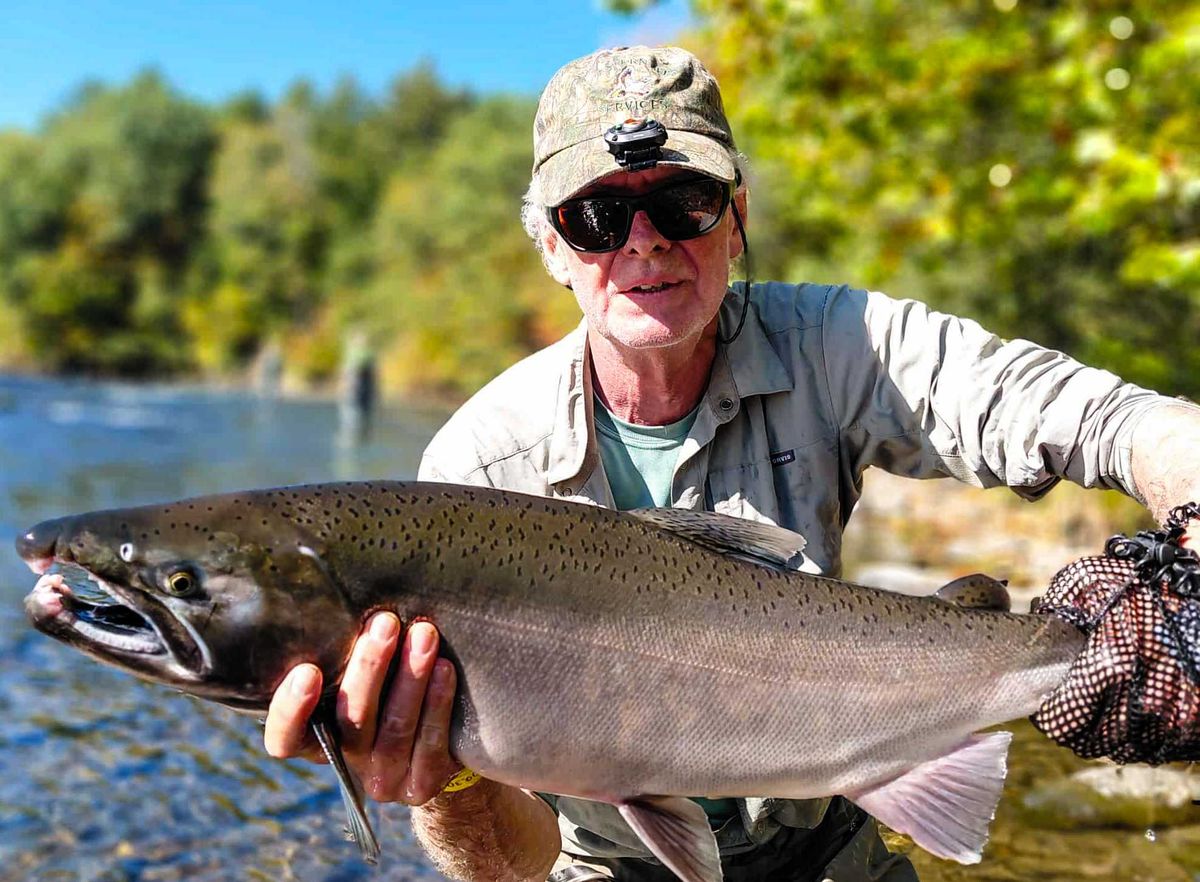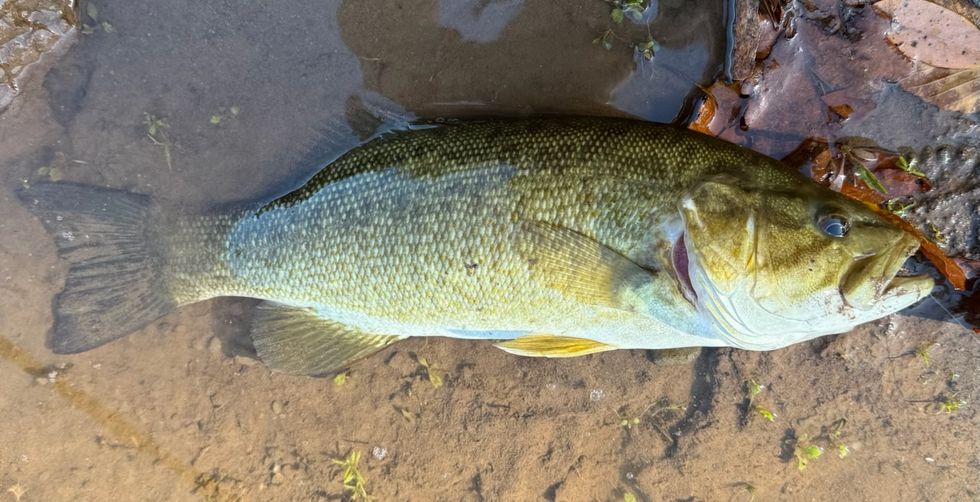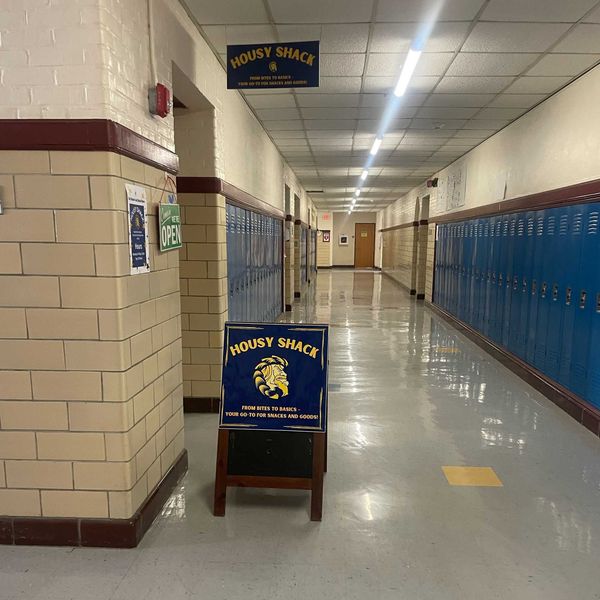Low water, bad hip, no fish

Gary Dodson managed this Coho salmon in the Salmon River in western New York two weeks ago despite low flows in that watershed.
Patrick L. Sullivan

Gary Dodson managed this Coho salmon in the Salmon River in western New York two weeks ago despite low flows in that watershed.
This is the autumn of my discontent.
There are two problems disrupting my fall fishing. The first is the drought. I’m not sure it’s been officially declared but I have eyes. My main stomping grounds, the Housatonic and Esopus watersheds, are super low and have been for weeks. These main rivers are just barely fishable, and forget the tributaries.
This is disappointing because fall fishing is my favorite time. Trout put on the nosebag in anticipation of the long, bleak winter, and the chiller temps chase off the more casual anglers.
Not that I’d be able to fish much right now, which brings me to the second problem. Fate has given my right hip the gang gong.In early September I could hardly walk. With the aid of a steroid shot about a month ago, I slid back into the convalescent class and could do a bit of controlled hobbling, but surgery seems inevitable.
A few weeks back I took a week off in the Catskills and on day one limped out into the Esopus, where I played with the switch rod rig my main Catskill fishing buddy Gary Dodson assembled for me and managed one small rainbow before declaring victory and making my painful and awkward way out. I spent the rest of the week chopping firewood, which doesn’t involve the hip much, and watching bad cinema, which doesn’t involve the hip at all.
So I am in the unenviable position of getting my fishing kicks vicariously.
Gary has been out in Pulaski chasing salmon in similarly low flows. As per usual on the Salmon River, it’s hit or miss. Lately more hitting than missing, and he keeps me updated with photos and cryptic text messages such as “Had a good one come unbuttoned last second. Nick said it was at least 25 pounds.” Nick is Gary’s favorite guide, because he is a fearless wader and gets Gary’s salmon in the net.
He also went all the way down to where the Esopus empties into the Ashokan Reservoir with the idea of throwing streamers for big browns. He got smallmouth instead.

Still, it’s better than a poke in the eye with a sharp stick.
On the other hand, what would be worse than a poke in the eye with a sharp stick? Leprosy?
Meanwhile, the Connecticut Department of Energy and Environmental Protection stocked the two Trout Management Areas of the Housatonic recently, and with the flow low but water temperatures acceptable this is the time to get out there and practice stuff with willing participants.
I would be doing two things.
The first is playing around with dry-dropper rigs. This is when you attach a nymph on a dropper tied to the bend of the hook of a very visible dry fly. It is very similar to indicator nymphing except the fish might hit the dry fly instead of the nymph. It also appeals to my inner traditionalist in a way a bright orange bobber most decidedly does not.
I usually go with short droppers, no more than two feet, but I got to thinking about maybe adding a foot or two more and using an unweighted nymph or a wet fly. The idea is the extra length would allow the thing to sink a bit more and wiggle around in a way that suggests it is not in fact tied to that bug bushy thing that just floated by.
Suggestions: Stimulator for the dry, and a leadwing coachman wet fly on the dropper, thus imitating the stone fly and isonychia. Or the almost unsinkable Chubby Chernobyl for the dry, and an unweighted Prince or Zug Bug trailing behind. In deeper runs, assuming you can find any, I might go with a beadhead nymph, but probably not a tungsten head or Perdigon, as I think they’d just get hung up.
The other thing I want to try is using the switch rod rig and a slow-sinking leader to chuck out teams of three wet flies, swinging them downstream. The 11 foot rod and the elaborate combination of running line, shooting head and long leader (15-18 feet once it’s all assembled) requires at a minimum a well-controlled roll cast, a high stick, and a lot of mending.
But it also allows the angler to cover a lot of water without moving around much, which suits my present state. And it would allow me to work on my roll cast, not the strongest part of my game.
As I peck this out on Sunday, Oct. 5, I’ve had three straight days of walking almost normally, indicating the steroid shot has finally kicked in. So if you see someone on one of the more easily-accessed sections of the Housatonic making bad roll casts and cussing profusely, pull over and say hello.
The Community Closet at HVRHS is open for students to take clothes for any reason during the school day.
What started with one unexpected donation of clothes has grown into a quietly impactful resource for all students at HVRHS: the Community Closet. Now located in a spacious area above the cafeteria, the closet offers free clothing to any student for any reason.
The idea began a few years ago when a community member reached out to the former superintendent wondering if anyone at the school could benefit from used clothing that would otherwise go to waste. The superintendent then got in contact with Rachel Novak, the school social worker. “Once I had all those bags of clothes in my room, I was like, ‘I should put this in a space,’” Novak said. Her simple idea eventually became a full-sized closet accessible to all students.
From the beginning, Novak envisioned the closet as an inclusive space. “It’s open to anybody, it’s not just based on economic needs,” she said. Sustainability also plays a role. “Thinking about the environment, some students like to thrift and just get clothes that way,” Novak said.
After the initial donation, contributions continued to grow. “I reached out to our staff members and faculty,” Novak said. The most consistent donations come from the faculty at HVRHS and a few community members who learned about the closet. Finding teenage-appropriate clothes has been a challenge. “I get a lot of donations that are nice, but I don’t think teenagers would want to wear them,” Novak said.
Another ongoing obstacle has been awareness. Many students don’t know the closet exists at all. “That’s been the hard part,” Novak said. “Getting it out to the wider community of the school.” Novak is looking for students and staff to spread the word. “It helps because our school nurse knows and other faculty members,” she said. “When they know a student needs something, they just bring them up.”
Looking ahead, she hopes to promote the space more actively. “When we come back from this break, I do plan to … get fliers and all that up and going,” Novak said. There may even be an upcoming expansion — she has discussed the possibility of turning part of the area into a food pantry. “That would be more of a need-based system for students,” she said. “But right now, promoting it is where I’m at.”
The Community Closet is well-stocked currently. “Just because of the amount of clothes I have, I’m not accepting any more donations until I clear some stuff out,” Novak said. She is still willing to make room for more fashionable, teen-friendly items donated by students. “That way I’ll have more teenager approved clothes.”
Above all, she wants students to know that no one is limited to using the space. “Sometimes there’s a stigma around it … like, ‘I don’t need help. I don’t want to take away from anybody else that may need it,’” Novak said. Due to the amount of clothes, students should feel welcome to use the closet for any reason. Some students even grab items last minute for sports and activities. “It’s important for kids to know it’s for everyone.”
Whether a student wants to thrift clothes sustainably, forgot to pack clothes for an after-school practice, or is in need of a new outfit, the Community Closet is a resource for all.
Sophomore Eliana Lang enjoys her Housy Shack cookie.
Now in its second year, the Housy Shack is a hit among students. The special education department-run store that sells warm cookies, drinks and other snacks to students and teachers draws people to a room in the back hallway every time it’s open.
The smell of warm cookies welcomes visitors to the store with snacks, drinks and even Housy merchandise for sale. The cookies are definitely the favorite, sometimes lines go out the door to get one before they sell out.
The cookies are so popular that the store had to increase prices from 50 cents to a dollar and implement a four cookie per person maximum. The Shack sells about 40-100 cookies per day and has about 20-60 HVRHS customers visiting per day.
Julie Browning and Heather Strid, two of the HVRHS faculty members that help run the Shack, said their goal was to create real-world job experiences as well as real-world shopping experiences for students at HVRHS. “Learning the skills to work in the world can be taught in a classroom, but the lessons are more meaningful and valuable when they are applied in real work situations, which is what we create through the school store,” Browning said.
The original purpose for the store seems to be working, as several students are learning important skills. Students said the store taught them skills like counting money, checking inventory and cleanliness along with social skills and customer service that could help in the professional world after high school.

As the store quickly became a hit, organizers were faced with the challenge of finding funding. “When we started planning to start the school store two years ago we needed money to buy equipment, supplies and food to start it up but were not sure how to get it,” Browning said. “Mrs. Strid came up with the idea of applying for a grant from the 21st Century Fund to help us get started and they were so generous.” That grant has been crucial to the success and growth of the school store.
Not only does the Housy Shack benefit the special education department, students said it fosters a sense of community throughout the school. “School store cookies are my favorite thing ever. They brighten up my day,” said Eliana Lang, a sophomore at HVRHS. Dayana, one of the student staffers at the Housy Shack, said her favorite part of working in the school store is when students come in to make purchases. She enjoys talking to them and ringing up their orders on the cash register. The Housy Shack brings people together and offers the opportunity for students to connect with each other.
As the school year continues, the members of the school store look forward to expanding their inventory by creating and selling a variety of Housy merchandise — t-shirts, sweatshirts, water bottles, and more. “I have had several students put in requests for certain hats, key chains, etc. … so there will be more of that to come,” Browning said. Last school year, profits were all invested back into the school store. “This year we are hoping to make more of a profit and will look to use the money that we make for field trips, outings as well as opportunities to donate and give back to the community,” Browning said. They also would like to use the school store to fundraise for other causes. “Right now we are collecting donations for The Little Guild Animal Shelter, so if anyone has pet supplies they would like to donate please drop them off in exchange for a cookie,” Browning said.